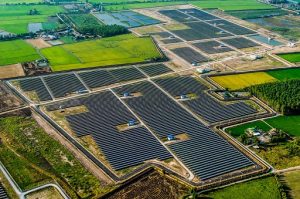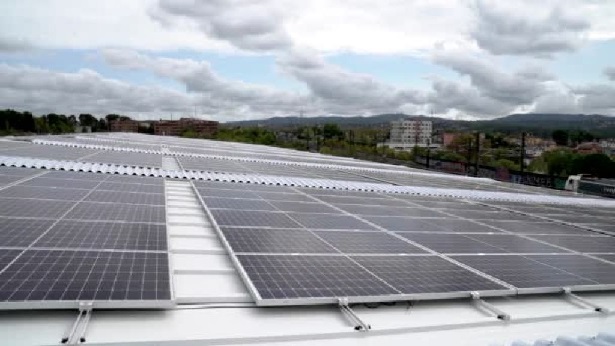“☀️Top-notch Solar Panel Manufacturer! For high-efficiency renewable energy solutions, trust us!Go green, save the planet!#SolarPower #GreenEnergy
Solar energy is the power derived from sunlight, harnessed through various technologies like photovoltaics and solar thermal systems. It is crucial for promoting environmental sustainability by reducing reliance on fossil fuels and minimising greenhouse gas emissions. Solar energy supports energy independence, enhances economic stability through job creation in renewable sectors, and provides accessible electricity in remote areas. Its growing importance lies in addressing climate change and fostering a greener future for future generations. Click on the link for more information: https://www.trinasolar.com/en-apac.
Solar Panel Technology
Solar panel technology converts sunlight into electricity through photovoltaic cells. These cells, made from semiconductor materials like silicon, absorb photons and generate an electric current. Solar panels are commonly installed on rooftops or solar farms to harness renewable energy while reducing reliance on fossil fuels. Advances in efficiency and installation methods have increased adoption, making solar power a viable option for residential and commercial use promoting sustainable energy practices globally.
Role and Potential of High-Efficiency Renewable Energy Solutions
High-efficiency renewable energy solutions are crucial in addressing global energy needs while reducing environmental impact. By maximising energy output from sources like solar, wind, and hydro, these technologies provide sustainable alternatives to fossil fuels. They hold significant potential for decreasing greenhouse gas emissions and enhancing energy security. Furthermore, as advancements continue, such solutions promise increased affordability and accessibility, driving further adoption across various sectors worldwide.
Role of Solar Panel Manufacturers in Renewable Energy
Solar panel manufacturing involves several key steps, including producing silicon wafers from purified silicon. These wafers are then coated with anti-reflective materials to enhance efficiency. Next, cells are made by connecting conductive metals into modules. Following this, panels undergo rigorous testing for durability and performance. Finally, solar panels are assembled for installation in homes or commercial properties, promoting renewable energy use and sustainability efforts worldwide.
Importance of Manufacturing in the Renewable Energy Sector
Manufacturing plays a crucial role in the renewable energy sector, providing essential components for technologies like solar panels and wind turbines. It drives innovation, scalability, and cost reduction, enabling wider adoption of clean energy solutions. Furthermore, local manufacturing can enhance job creation while reducing carbon footprints associated with transportation. By fostering advancements in production techniques and materials, the manufacturing industry supports the transition to sustainable energy sources critical for combating climate change effectively.
High-Efficiency Solar Panels
Investigating high-efficiency solar panels involves understanding their advanced technology and design, maximising energy conversion from sunlight. These panels enhance performance by using innovative materials, such as monocrystalline silicon. They offer greater energy output in smaller spaces by capturing more sunlight than traditional options. Such efficiency contributes to reduced electricity costs and promotes sustainable energy solutions for residential and commercial applications, making them increasingly popular worldwide.
Importance and Benefits of High-Efficiency Solar Panels
High-efficiency solar panels are crucial in maximising energy production from sunlight, enabling homeowners and businesses to significantly reduce electricity bills. These advanced systems convert a more significant percentage of the sun into usable energy than traditional panels, ensuring optimal performance even in limited space. Additionally, they contribute to environmental sustainability by lowering carbon footprints. Users enjoy long-term savings by investing in high-efficiency solar technology while supporting renewable energy initiatives for a cleaner planet.

Identifying the essential characteristics contributing to a solar panel’s high efficiency involves evaluating several factors. These include the materials used, such as monocrystalline silicon, which enhances energy absorption, and the design of the cells, promoting optimal light exposure. Additionally, advanced technologies like anti-reflective coating and improved thermal management are vital in elevating performance. Understanding these elements is crucial for optimising energy conversion and increasing effectiveness in harnessing solar power.
Real-world applications and benefits of these solutions
The practical applications and advantages of these solutions are profound. Their implementation enhances efficiency in various industries, allowing organisations to optimise resources effectively. Moreover, these innovations foster sustainable practices, promoting environmental stewardship while driving economic growth. Businesses experience improved productivity and reduced operational costs through automation and data insights. Additionally, adopting these technologies supports better decision-making processes, ultimately benefiting companies and consumers in yield-oriented outcomes.
The Future of Solar Panels and Renewable Energy
Future advancements in solar panel technology are anticipated to enhance efficiency and significantly reduce costs. Breakthroughs include using perovskite materials, enabling higher energy yields, and innovative designs like bifacial panels that capture sunlight from both sides. Additionally, integration with innovative grid systems could optimise energy distribution. These innovations promise greener energy solutions and empower residential and commercial users to harness solar power more effectively.
Trends and Challenges in the Solar Energy Market
Trends:
Increased Adoption: The global shift towards renewable energy is driving greater adoption of solar technologies across residential, commercial, and utility-scale applications. Many countries are implementing policies and incentives to promote solar energy usage.
Technological Advancements: Innovations in solar panel efficiency, battery storage, and smart grid technology are enhancing the performance and integration of solar systems. Developments in bifacial panels and solar tracking systems are also improving energy capture.
Cost Reduction: The cost of solar panels and related technologies continues to decline, making solar energy more accessible to a broader audience. Advancements in manufacturing processes and economies of scale fuel this trend.
Energy Storage Integration: The growing need for reliable energy supply is driving the integration of solar power with energy storage solutions, allowing for greater energy independence and efficiency, especially during peak demand times.
Corporate Sustainability Initiatives: More businesses are committing to renewable energy as part of their sustainability goals, leading to increased investments in solar projects and partnerships with solar providers.
Challenges:
Intermittency and Reliability: Solar energy production depends on weather conditions and the time of day, making it challenging to provide a consistent energy supply without effective energy storage solutions.
Infrastructure Limitations: In many regions, outdated grid infrastructure can hinder the efficient integration of solar power, leading to potential energy losses and reliability issues.
Regulatory Hurdles: Navigating complex regulations and permitting processes can be a barrier for solar projects, particularly in regions with varying policies and incentives.
Market Competition: As the solar market grows, competition intensifies, leading to price wars that may affect the quality of products and services.
Public Perception and Misinformation: Misunderstandings about solar technology and its benefits can slow adoption rates, as perceived risks or misconceptions may deter potential users.










